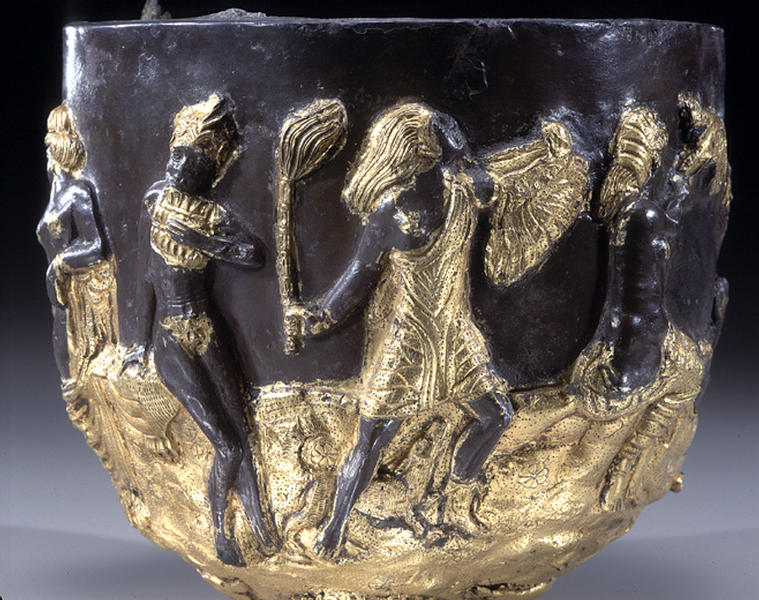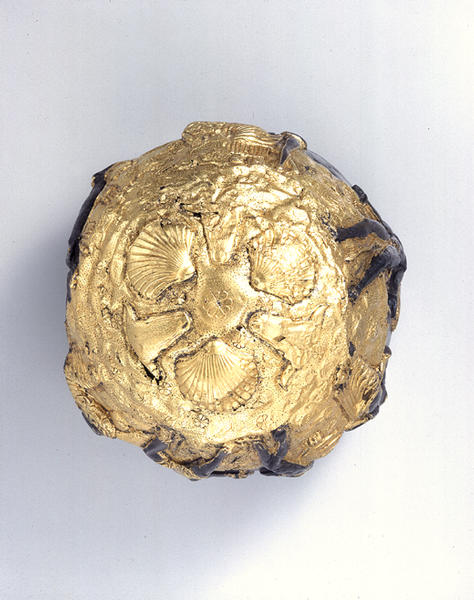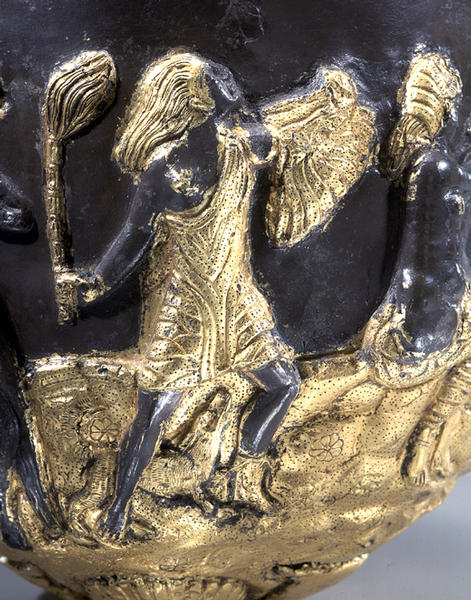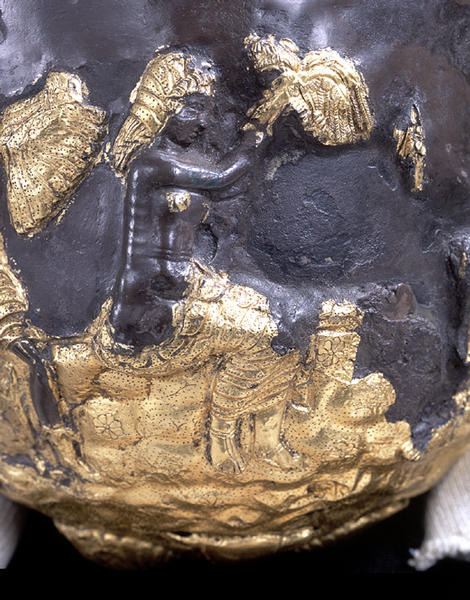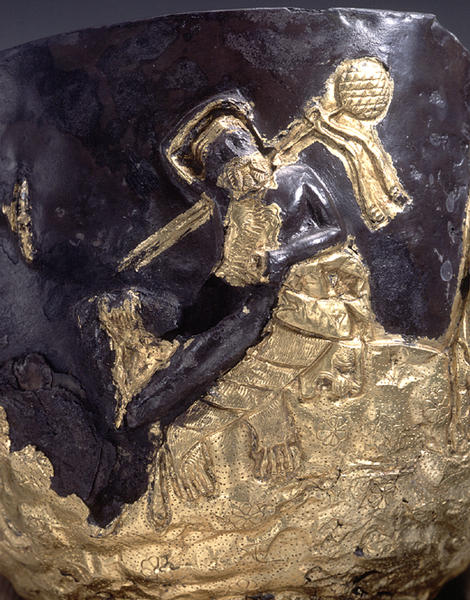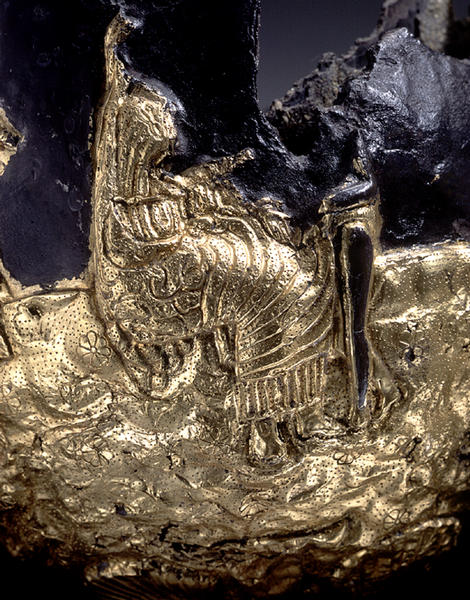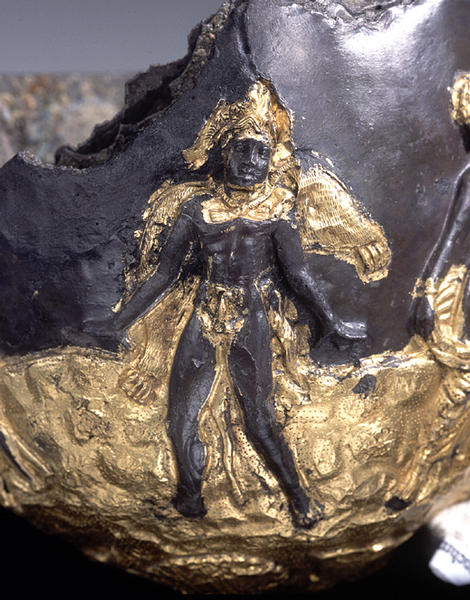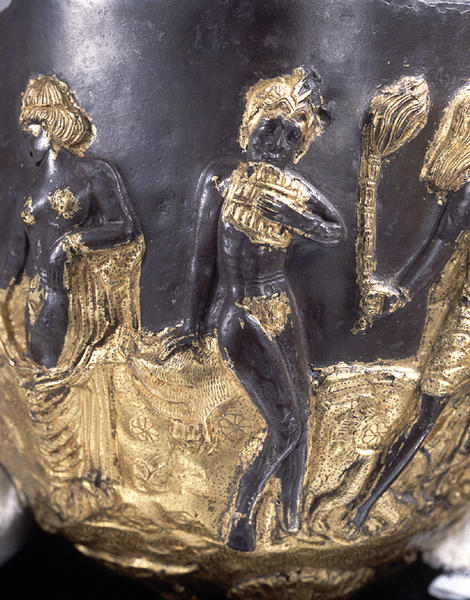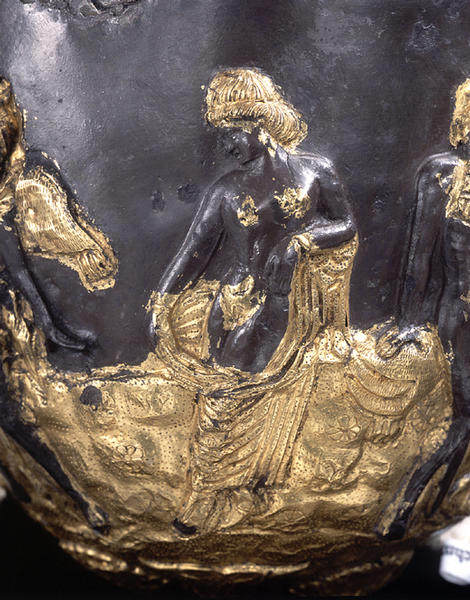人物装飾鉢
- バクトリア
- 紀元前4-紀元前2世紀頃
- 貼金銀
- H-13.2 D-15.5
金製・銀製容器(古代バクトリア遺宝展)
バクトリア遺宝で容器は大きな部分を占め、22点の金器(作品123~144)、26点の銀器(作品97~122)が含まれる。銀器の中には背の高いアケメネス朝の灌頂用ゴブレット型をしたものが6個(作品103~106、108、109)あるが、その装飾はヘレニズム期の特徴をもっている。これに似たカップを、線刻や押し出し技法で奉納金板に表された神官が持っている。同様に灌頂用のリュトンが5個(作品116~119、122)あるが、その内3個(作品118、119、122)は器前方の断片である。更に8個の銀製灌頂用浅鉢(作品97~99、101、102、111~113)があるが、金製の器と同様の目的に使われた。18個の金製灌頂用鉢(作品123~140)は等しく丸い底と広がった縁をもっている。ピクシス型をした容器(作品142)は蓋がついており、これらの器の中では一番古い部類に属している。特に興味深いものは香炉(作品141)で内側に四つの環が付き、これに紐をとおして提げたものであろう。
これらの器は概して大英博物館のオクサス遺宝よりも大振りであるが、同じ用途に使われたものと思われ、ペルセポリスの浮彫に刻まれた人物が持つ器に近い形状をしている。この関連からこれらの器の年代を考えることができる。これとともに、ペルセポリス型のゴブレットやリュトンを作る光景が、エジプトのヘルモポリス・マグナにあるペトシリスの墓のプロナオスに浮彫で表されていることは特筆に価する。マスカレラによれば、この浮彫は前300年頃の鍛金工房の様子を描いたものに相当する。
牡鹿形リュトン
香炉
ロゼット文浅鉢
ロゼット文浅鉢
ロゼット文フィアラ杯
ロゼット文鉢
フィアラ杯
ロゼット文浅鉢断片
ロゼット文鉢
ロゼット文鉢
ロゼット文鉢
ロゼット文鉢
ロータス・パルメット文鉢
ロゼット文鉢
人頭装飾鉢
ロゼット文鉢
植物文杯
ケートス文皿
鉢
獅子頭形杯
馬形リュトン
馬形リュトン断片
ラマッス形リュトン断片
双獅子形柄杓装飾
円盤(鏡)
ライオングリフィン形リュトン断片
浅鉢
浅鉢
浅鉢
鉢
鉢
鉢
鉢
鉢
鉢
鉢
鉢
鉢
鉢
鉢
鉢
鉢
鉢
鉢
蓋付鉢
解説(古代バクトリア遺宝展)
前4―前2世紀頃
貼金銀
高13.2 cm 径15.5 cm
この器の基本的な形状は、寸胴の器胎の末端が半球状になっている。これはギリシャのスキュフォス杯に類似しているが、圏足と把手を欠いている。外側に様々な人物を含む場面が描き出されている。底面貼金の地文には小さな8弁のロゼット文と刻点を施している。
器側面に見られる長髪の人物(106頁、a)は膝までの短いチュニックを着、松明を右手に持ち、左腕に衣をかけ、左足に短いブーツを履いている。はだけた右側の胸の隆起から見て、女性であると思われる。彼女は犬を伴っている。この人物に向かって右回りに、上半身が裸形の右を向いて座る女性で、小さい有翼の人物を抱えている(b)。有鬚でライオンの毛皮に座りチュルソスを伴う人物はディオニュソスの表現と考えられるc。その右に座る長いキトンを着た女性の前に子供が立っている(d)。その右にはライオンの毛皮をまとい前脚の皮をヘラクレス結びにしている男性が正面向きに立っている。その両腕は下向きに広げられている(e)。その右に両手に衣を持って広げ、腿まで露わにした女性が、後の岩に寄りかかっているが、足にはブーツを履いている(f)。その右にはライオンの皮を敷いた岩にパンフルートを吹く男性が浅く腰掛けている(g)。
底面の中心には8弁のロゼット文を配し、その周りに三つのブクラニア(牡牛の頭部)と三つの貝殻意匠を交互につけている。これらの図像の解釈は困難であるが、ブクラニアが供犠を暗示していることから、これが儀式に使われた可能性は大きい。
Catalogue Entry
ca. 4th‐2nd century B.C.
Gold plated silver
H. 13.2 cm, Dia. 15.5 cm
The basic form of this vessel is a semi-circular torso with simple edges. This vessel form resembles the skyphos vessel of Greece, but is lacking the circular foot or handle. The outer surface of this vessel shows a scene which features various people. The base of the vessel is plated in gold and is decorated with an incised, eight-petal rosette.
The long-haired figure (a) seen on the side of the vessel is wearing a short, knee-length tunic and holds a torch in her right hand while her left arm is draped in a garment. She wears short boots. The bared right chest protrudes, and thus we can tell that the figure is female. She has attendant of a dog to the right, a woman naked in her torso, is seated and facing to the right, and grasps a small winged human (b). Figure c is thought to represent a bearded figure of Dionysus, seated on a lion skin and accompanied by a thyrsus. Figure (d) is to the right of c shows a seated female figure wearing a long chiton and with a child standing in front of her. Figure (e) is to the right of (d) and is a standing figure of a man facing forward, draped in a lion's skin, with the forelegs tied in a Hercules knot. Both of the figures arms hang down and are spread outward. Figure (f) is to the right of (e) and is a woman holding drapery in both extended arms, and she is nude to the thighs. She leans against the boulder behind her and she wears boots on her feat. Figure (g) is to the right of (f), and is a male figure lightly seated on a lion skin spread on the rock and is seen playing a pan flute. This vessel shows the eight-petalled rosette decorating the center of the base, surrounded by three bucranium (ox heads) which alternate with three shell designs. These images are hard to interpret, but the hints of a bucranium sacrifice make it highly likely that this vessel would have been used in a ritual setting.
Vessels
The "vessels" division is represented by a relatively large number of objects.There are 22 items of gold (cat. Nos. 123-144) and 26 of silver (cat. Nos. 97-122). Among the silver vessels, there are 6 goblets (cat. Nos. 103-106, 108, 109) tall libation vessels Achaemenid in form, but decorated in a style which is typically Hellenistic. Similar cups are held by the magi represented on the relief sculptures and votive plaques. Three rhyta made for a similar purpose are unfortunately in a fragmentary condition (cat. Nos. 118, 119, 122). In addition there are 8 shallow bowls (cat. Nos. 97-99, 101, 102, 111-113) for ritual libations. The gold vessels were used for the same purpose; there are 18 libation bowls, of simple form, most of which have a rounded base and everted rim (cat. Nos. 123-140). One tall vessel of a pyxis type with a lid (cat. No. 142) appears to be the earliest of the vessels in the collection. Of special interest is an incense burner in the form of a censer with four rings for suspension (cat. No. 141).
Although the number of vessels in this collection is considerably larger than those of the Oxus Treasure in the British Museum, they probably served the same function. The vessels of both collections are closely paralleled by the vessels held by worshippers depicted on the Persepolis reliefs. This observation makes it possible to date them. It is worth adding here that the manufacture of goblets of similar shape and of rhyta in the Persepolitan style is depicted on a relief in a pronaos on the northern wall of the tomb of Petosiris at Hermopolis Magna in Egypt. According to Muscarella, the reliefs attest the manufacture of embossed articles in Egypt right up until 300 BC.
牡鹿形リュトン
香炉
ロゼット文浅鉢
ロゼット文浅鉢
ロゼット文フィアラ杯
ロゼット文鉢
フィアラ杯
ロゼット文浅鉢断片
ロゼット文鉢
ロゼット文鉢
ロゼット文鉢
ロゼット文鉢
ロータス・パルメット文鉢
ロゼット文鉢
人頭装飾鉢
ロゼット文鉢
植物文杯
ケートス文皿
鉢
獅子頭形杯
馬形リュトン
馬形リュトン断片
ラマッス形リュトン断片
双獅子形柄杓装飾
円盤(鏡)
ライオングリフィン形リュトン断片
浅鉢
浅鉢
浅鉢
鉢
鉢
鉢
鉢
鉢
鉢
鉢
鉢
鉢
鉢
鉢
鉢
鉢
鉢
鉢
蓋付鉢
